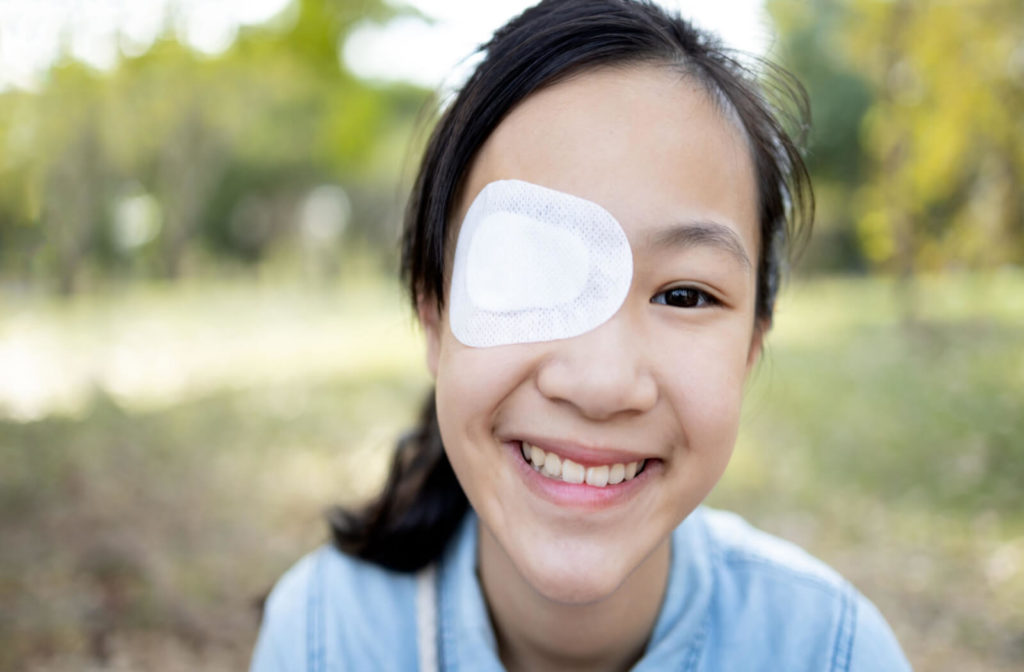Lazy eye or amblyopia is a condition in which one eye does not work as well as the other. It starts in childhood, and therefore regular eye exams are crucial for screening for signs of lazy eyes.
When a lazy eye is detected, diagnosed, and treated before age 6, it can resolve completely and prevent long-term vision problems in children.
Let’s take a closer look at this condition in children, the causes, signs and symptoms, and treatment options.
More About Lazy Eye
Lazy eye is reduced vision in one eye because the eye and the brain aren’t working together. The brain doesn’t recognize vision from one eye and relies more on the stronger eye causing sight in the weaker eye to not develop as fully.
Up to 3 out of 100 children have amblyopia. Children with this condition have good vision in their working eye but cannot see clearly out of the weaker eye.
What Causes Lazy Eye?
Lazy eye is caused by conditions that interfere with normal brain-eye connections. These include:
Refractive Errors
Refractive amblyopia occurs when both eyes have different vision strengths. One or both eyes may be nearsighted, farsighted, or have astigmatism in different amounts. When the brain receives poor visual images from the weak eye, it relies more on the other eye.
Strabismus
Strabismic amblyopia is the misalignment of the eyes where they don’t move together or line up correctly. One eye may turn in, out, up, or down.
When both eyes try to focus while pointing in different directions, it causes double vision. The brain in turn will ignore the image from the misaligned eye to prevent confusion.
Deprivation
Deprivation amblyopia is the result of an obstruction to vision. Vision blockage in an eye, such as a cataract, (cloudy area in the lens of an eye), or droopy eyes, (sagging eyelid), can prevent proper development of visual acuity.
Who Is at Risk for Developing Lazy Eye
Amblyopia can be present at birth or develop in children aged clear to age 9. At Age 9, the brain is done mapping what the eyes see. Risk factors that can increase the likelihood of a child getting lazy eye include:
- Premature birth
- Smaller than average size at birth
- Family history of lazy eye
- Developmental disabilities or delays
Signs & Symptoms of Lazy Eye
Lazy eye is a condition that is not always obvious or detected without an eye exam. Parents can look out for the following signs and symptoms of lazy eye:
- Tilting the head
- Squinting
- Shutting one eye
- Misaligned eyes
- Poor depth perception
- Reading difficulties
Lazy Eye Diagnosis
An eye doctor will look closely at your child’s vision and evaluate both eyes for signs of lazy eye or strabismus. Eye exams are crucial in picking up signs of the lazy eye early.
According to the American Optometric Association, the recommended eye exam interval for children is between 6 months and 12 months of age, age 3, and then yearly after age 4.
Treatment for Lazy Eye
When caught early, treatment can help a child’s long-term vision. There are many different kinds of treatment, and with the help of your eye doctor, you can decide which one works best for your child.
Glasses
For lazy eyes caused by refractive errors, glasses can correct and restore vision in the weaker eye and thus allow the brain to use both eyes together.
Eye Patch
Patching involves putting an eye patch over the stronger eye to force the use of the weaker eye. For this technique your eye doctor will prescribe daily exercises for as little as 20 minutes a day, depending on severity. It may take several months of consistent patching to see vision improvement.
Atropine Drops
Atropine eye drops work similar to an eye patch. The drops blur vision in the stronger eye, forcing the brain to use the weaker eye. Some children prefer this method over wearing a patch.
Surgery
Surgery is an option if other treatment methods don’t improve vision. It can also be used to correct an eye misalignment or to remove a congenital cataract.
Early Treatment Better Vision
It is essential for parents to have their child’s eyes examined early in life for any signs of amblyopia by an eye doctor who specializes in pediatrics and amblyopia. This ensures a proper diagnosis and treatment plan, ease in your child’s eye movements, and ultimately easier learning.
If you are concerned about your child’s vision, book an appointment with Family Focus Eyecare so we can address their vision-related issues early.



